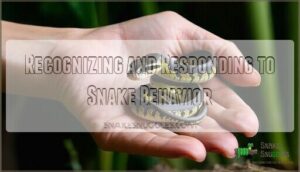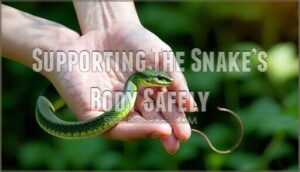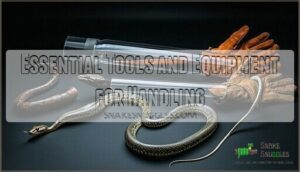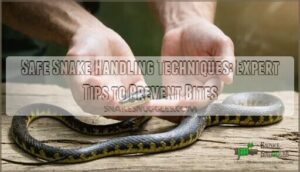This site is supported by our readers. We may earn a commission, at no cost to you, if you purchase through links.
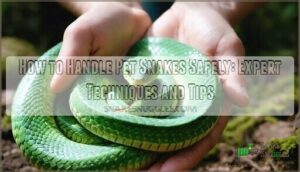 A snake’s muscular body can wrap around your arm with surprising force, yet most accidents in which you pick them up happen because people grip too tightly or hold in the wrong place. The difference between a calm snake that tolerates being picked up and one that strikes defensively often comes down to technique—where you place your hands, how you support the body’s weight, and whether you’ve washed away the scent of your last meal.
A snake’s muscular body can wrap around your arm with surprising force, yet most accidents in which you pick them up happen because people grip too tightly or hold in the wrong place. The difference between a calm snake that tolerates being picked up and one that strikes defensively often comes down to technique—where you place your hands, how you support the body’s weight, and whether you’ve washed away the scent of your last meal.
Learning proper methods for picking them up protects both you and your snake from stress, injury, and the behavioral problems that develop when animals feel constantly threatened. Master these fundamental techniques and you’ll transform sessions where you pick them up from anxious encounters into opportunities to build trust with one of nature’s most misunderstood creatures.
Table Of Contents
Key Takeaways
- Most snake bites during handling stem from incorrect technique—gripping too tightly, holding the wrong body sections, or approaching at the wrong time—rather than from the snake’s natural aggression or temperament.
- Proper body support requires using both hands to distribute weight evenly across the snake’s mid-body section while avoiding the head and tail, which triggers defensive or stress responses that compromise safety.
- Reading behavioral cues like hissing, body stiffness, rapid tongue flicking, and coiling patterns allows you to identify stress before it escalates, making timing and approach adjustments critical to preventing defensive strikes.
- Post-handling protocols including thorough handwashing, equipment sanitization, and secure enclosure checks prevent disease transmission, bacterial contamination, and escapes that commonly result from rushed or incomplete care routines.
How to Prepare for Safe Snake Handling
Safe snake management starts long before you actually pick up your pet. The way you prepare yourself and the space around you can mean the difference between a calm interaction and a stressful one for both you and your snake.
Here’s what you need to do before reaching into that enclosure.
Washing and Sanitizing Hands Before Handling
Washing your hands before picking up a snake isn’t just good hygiene—it’s about removing food scents that could trigger a feeding response and lead to an unintended bite. Here are the safe practices you should follow:
- Wash your hands with unscented soap for at least 20 seconds
- Use hand sanitizer afterward for eliminating scents completely
- Avoid lotions or perfumes that mask your natural smell
- Wait a few minutes before interacting to let sanitizer evaporate
- This routine protects snakes while reducing bites and preventing salmonella transmission
Wearing Protective Gloves and Boots
Once your hands are clean, the right gear—especially gloves and boots—adds another layer of protection against bites and keeps interaction safer for both you and your snake. Choose thick leather or puncture-resistant glove material that offers solid bite protection without restricting movement. Safety gloves reduce injury risk while maintaining dexterity.
Boots protect your feet and ankles during floor interaction. This protective clothing reinforces hygiene practices and keeps you confident during every interaction.
Setting Up a Clean, Clutter-free Environment
After you’ve got your protective gear on, your interaction space needs the same attention—a tidy, obstacle-free area prevents accidents and keeps your snake from slipping into hiding spots or getting injured on sharp edges. Remove hazards from the snake enclosure and surrounding space.
Monitor temperature control and humidity levels to reduce stress. Keep enrichment items organized. Proper cage sanitation and attention to snake habitat considerations create a secure snake environment for safe interaction.
Choosing The Right Time to Handle (post-feeding, Shedding Cycles)
Timing matters just as much as your setup—you can’t expect a cooperative interaction if your snake is digesting a meal or preparing to shed its skin. Avoid these critical windows for safe snake interaction:
- 48-72 hours post-feeding to prevent digestion interruption and regurgitation
- During opaque eye phase when shedding sensitivity peaks
- Immediately after shed completion until the snake rehydrates
- Breeding season when hormonal changes affect snake behavior
- Extreme temperature fluctuations that compromise frequency safety
Respecting these seasonal considerations and physiological cycles reduces stress and bite risk during snake care routines.
Sanitizing Handling Space and Equipment
Before you pick up your snake, every surface and tool in that interaction space needs to be as clean as the environment you’d want for yourself—bacteria and parasites don’t respect good intentions.
Wash your hands with antiseptic before interacting, then use reptile-safe disinfectant types on snake interaction equipment like hooks and tubes. Rinse thoroughly to eliminate residue removal concerns. Rotate equipment between uses and store in clean containers.
Follow cage sanitation and snake safety guidelines consistently—proper snake care tips begin with hygiene.
Recognizing and Responding to Snake Behavior
Your snake’s body language tells you everything you need to know about whether it’s safe to pick up. Learning to read stress signals and emotional cues helps you avoid bites and keeps interactions calm for both of you.
Here’s what to watch for and how to respond appropriately.
Identifying Signs of Stress, Fear, or Aggression
Your snake’s behavior is like a warning light on a dashboard—when stress indicators appear, you need to pay attention. Watch for heavy breathing, frantic escape attempts, or rapid tongue flicking that spikes during interaction. Aggressive responses often follow stress, with snakes striking or tensing their bodies when feeling fearful or aggressive. Physiological signs like elevated heart rates and body stiffness reveal deeper distress. It’s also important to note that tense body language is a key sign of moderate stress.
Poor enclosure conditions—wrong temperatures or tight spaces—exacerbate these reactions, making identifying snake behavior critical before every interaction.
Understanding Hissing, Body Language, and Vibrations
Hissing functions as your snake’s primary defensive signal, with frequencies usually ranging from 3,000 to 13,000 Hz—a sound meant to make predators think twice. When you hear this, watch for paired body language: flattened heads, raised necks, and tight coiling all signal escalating fear or snake aggression. Some species use mimicry functions, imitating venomous relatives for protection.
Snakes also detect vibrations below 150 Hz through ground contact, responding to footsteps before you’re close. Understanding snake behavior and reactions through these acoustic and physical cues helps you identify snake behavior accurately and avoid unnecessary stress during care. Observing their actions, such as raised head displays, can further clarify their emotional state.
Adjusting Handling Based on Emotional State
Once you’ve decoded your snake’s emotional signals, the real skill lies in matching your interaction approach to what they’re actually feeling in that moment. Reading snake cues helps you decide whether to proceed or postpone. If you notice snake aggression or anxieties about being picked up, step back and give them space.
Calming techniques like slower movements and gentle positioning aid snake behavior management. Building trust through positive reinforcement gradually improves snake temperament and reduces scenarios involving aggressive snakes over time.
How Snakes Use Wrapping for Stability
When a snake coils around your arm or wrist, it’s not trying to squeeze you—it’s simply seeking a secure anchor point to keep from falling. Constricting snakes use their muscle control and grip strength to stabilize themselves on surfaces, an evolutionary advantage that helps them navigate branches and uneven terrain.
When you interact with your snake, expect coiling patterns that adjust to surface texture. Support the snake’s head and the snake’s tail to reduce its need for tighter gripping.
Step-by-Step Snake Handling Techniques
Once you’ve prepared your space and learned to read your snake’s signals, it’s time to put that knowledge into practice.
The actual holding process requires deliberate movements and proper body support to keep both you and your snake comfortable. Here’s how to pick up your pet snake step by step.
Approaching and Alerting The Snake Calmly
Before you reach into the enclosure, remember that snakes don’t have eyelids—they see everything you do, and sudden movements can trigger a defensive response.
A gentle introduction starts with soft noises—a calm voice or light tap on the enclosure signals your presence. Move slowly when you pick up your snake, keeping a calm demeanor throughout.
Safe snake pickup techniques depend on avoiding startling the animal, so let your snake see your approach and adjust to your presence before contact.
Supporting The Snake’s Body Safely
The way you support a snake’s body determines whether it feels secure or threatened during holding. Proper mid-body support distributes even weight across your hands, preventing injury to the snake’s spine.
When you hold your snake, focus on these safe snake holding techniques:
- Lift around the middle third of the body to provide secure grip without restricting movement
- Keep one hand supporting the lower third to prevent the snake from dangling, which causes stress
- Match your style of approach to the snake’s size—larger snakes need more contact points for stability
These safe snake holding methods help you confidently approach snakes while avoiding injury.
Using Both Hands for Balanced Support
Single-hand support works for small snakes, but most species need both hands to feel stable and move naturally. Your upper hand maintains a secure grip while your lower hand prevents dangling, creating even weight distribution across the snake’s body.
This body alignment prevents injury to the spine and builds confidence as you feel the snake relax. When you interact with snakes with coordinated support, they’ll move smoothly between your hands without stress.
Avoiding The Head and Tail During Handling
With your support system in place, you’ll want to focus on the middle section of the body—keeping your hands away from the head and tail protects both you and your snake from unnecessary stress or injury.
The snake’s head houses defensive instincts that trigger head strike avoidance responses, while the snake’s tail can activate autonomy defense behaviors.
Focus on gentle body support through the mid-body region when you pick up your snake, preventing spinal injury and avoiding constriction reflexes that safe snake practices emphasize.
Increasing Handling Time Gradually
Once you’ve mastered the basics of mid-body support, building your snake’s comfort through short, consistent sessions will help both of you develop trust without overwhelming either party. Start with five-minute interaction duration intervals and watch your snake’s comfort levels closely.
Session frequency matters—aim for three times weekly at first. As your snake relaxes, you can extend these periods through gradual introduction while using positive reinforcement.
This approach to safe snake interaction builds confidence in both person and reptile.
Essential Tools and Equipment for Handling
Having the right equipment makes snake restraint safer and more controlled. The tools you choose depend on your snake’s size, temperament, and species.
Let’s look at what you’ll need to work with your snake properly and maintain a safe environment for both of you.
Using Snake Hooks and Tubes Safely
Snake hooks and tubes aren’t just convenient tools—they’re your first line of defense when working with unfamiliar, nervous, or venomous snakes. A hook lets you gently guide and lift a snake without direct contact, reducing stress for both caregiver and animal. Choose the right hook material and tube size for your species:
- Alert the snake with a soft noise before approaching
- Touch gently mid-body with the snake hook
- Lift carefully, keeping the snake elevated or on flat surfaces
- Control movement without restricting natural behavior
- Sanitize all snake equipment after each use
These snake restraint methods prioritize injury prevention while respecting ethical considerations in reptile care.
Choosing Gloves and Protective Clothing
Protective gear matters more than you might think—the right gloves and clothing can mean the difference between a confident holding session and an unexpected trip to urgent care.
Choose safety gloves made from bite-resistant materials like leather or heavy-duty synthetic blends. Proper fit prevents slippage during safe snake holding, while sturdy boots protect your ankles.
Consider allergy considerations when selecting glove materials, and make certain clothing types cover vulnerable skin without restricting movement.
Handling Large or Aggressive Snakes With Assistance
When your snake measures over six feet or shows aggressive tendencies, you’ll need a second experienced caretaker to make certain everyone stays safe.
Teamwork safety requires clear communication signals—establish verbal cues before you begin. One person controls the head using a snake hook or snake tongs while the other braces the body.
When managing feisty snakes, restraint techniques must be coordinated, and specialized equipment like tubes can help redirect movement. Always discuss emergency protocols beforehand so both caretakers know exactly what to do if the situation escalates.
Sanitizing Tools After Use
After every interaction session, your hooks, tubes, and tongs carry bacteria and waste particles that can harm both you and your snake if left unchecked. Follow these tool disinfection methods to prevent cross-contamination risks:
- Rinse equipment with warm water to remove visible debris
- Apply reptile-safe sanitizer and let it sit for the recommended contact time
- Dry completely before storage after sanitizing in a clean, designated area
Sanitizing frequency should match your interaction schedule—after each use for aggressive snakes, weekly for docile species. Always wash your hands after cleaning snake equipment.
Ensuring Cage Security Post-handling
Snakes can slip through openings smaller than your thumb, so double-checking every latch and seal isn’t paranoia—it’s prevention. These escape artists excel at exploiting weak points in your vivarium. Test each lid’s security by gently pulling upward before walking away.
While you’re checking enclosure integrity, scan for feces removal needs—cleaning waste immediately fosters hygiene practices that keep your snake enclosure safety standards high and escape prevention reliable.
Education, Species Selection, and Post-Handling Care
Once you’ve mastered the mechanics of interacting, you’ll need to think about the bigger picture—choosing the right snake, teaching others to do the same, and keeping things clean and safe after each session.
The species you pick, the education you provide, and your post-interacting routine all play a role in preventing bites, escapes, and health issues.
Here’s what you need to know to close the loop on responsible snake ownership.
Educating Owners and Children on Snake Safety
Teaching someone to care for a snake safely isn’t just about technique—it’s about building respect and confidence that prevents mistakes before they happen.
Walk new owners through child-safe practices and responsible ownership principles, emphasizing ethical considerations and fear alleviation.
Demonstrate safe snake care techniques and explain how caring for snakes correctly reduces bite risk. Use clear, hands-on education to show owners what stress signals look like, so they can prevent snake bites before tension escalates.
Recommended Beginner-friendly Snake Species
Choosing your first snake matters more than you might think. Corn snakes stand out as top contenders for beginner species—reaching just 3-5 feet, they’re naturally calm and live 10-15 years with proper care. Ball pythons also rank high among docile snake breeds, tolerating gentle interaction once acclimated and thriving for 20-30 years. California kingsnakes offer vibrant patterns and easy-to-manage temperaments, while rosy boas stay small and manageable.
For affordable snake morphs, common corn snake hatchlings start around $25-40, making them accessible low-maintenance species for new keepers learning safe snake care with nonvenomous snakes.
Special Care for Different Snake Temperaments
You’ll find temperament varies widely—even within the same species. Juvenile snake management demands extra caution since younger individuals bite over 30% more often than adults.
Approaching bold snakes requires confidence but watch for stress signs, while shy snake management works best with gradual acclimation in enriched environments.
Aggressive snake care means reading body language closely: hissing, coiling, and rapid tongue flicking signal you should back off.
Social context effects matter too—pair housing can shift snake personality and behavior by up to 26%.
Cleaning Up After Handling and Preventing Escapes
The moment you return your snake to its enclosure, your job shifts from caretaker to housekeeper—and a secure latch is just as important as the cleanup itself. Double-check your snake’s cage latches and locks to eliminate escape risks.
Remove feces immediately to maintain a sanitary environment and prevent germ buildup. These safe snake care techniques protect both you and your snake while ensuring proper snake enclosure safety and preventing snake bites through responsible post-care protocols.
Washing Hands and Maintaining Hygiene After Handling
Your hands carry bacteria, oils, and saliva even after you’ve secured the enclosure, so thorough handwashing with soap and warm water is the final step in protecting yourself from Salmonella and other snake-borne pathogens.
Germ transfer prevention reduces zoonotic disease risks that come with safe snake care techniques.
These safe practices complete your snake safety precautions routine, ensuring a sanitary environment while maintaining proper cage lid security and feces cleanup importance.
Frequently Asked Questions (FAQs)
What are common mistakes new snake owners make?
People tend to fuss over feeding schedules, yet overfeeding remains a top mistake alongside wrong substrate choices, poor heating setups, ignoring signs of illness, and infrequent interaction that prevents proper snake interaction skills from developing.
How often should you handle your pet snake?
Most snakes benefit from 10 to 15 minutes of interaction two to three times per week.
Individual needs vary by species and temperament, so watch for signs of stress and adjust your interaction schedule accordingly to avoid overinteraction consequences.
Can snakes recognize their owners over time?
Believe it or not, there’s more than meets the "eye" regarding snake cognition. Your snake won’t fetch your slippers, but scent recognition and habituation evidence suggest these reptiles distinguish familiar caretakers from strangers.
Individual variation matters—some species show stronger bonding potential through consistent, safe snake care techniques. They track your unique scent profile rather than facial features, responding to predictable snake interaction patterns.
Understanding snake behavior and reactions helps you appreciate each snake personality, even if true recognition remains scientifically debated.
What should you do if your snake bites?
If bitten, stay calm and gently place your snake back in its enclosure.
Wash the bite area thoroughly with soap and water, then apply an antiseptic.
Monitor for infection signs like swelling or redness, and seek medical attention if symptoms worsen.
How do you transport a snake safely?
Planning a trip with your snake? Use a secure, well-ventilated travel enclosure sized appropriately for your reptile. Maintain temperature regulation throughout transport duration to reduce stress.
Always utilize proper snake restraint equipment like snake tubes for safe containment, making sure your snake restraint tools prevent escape during the journey.
Conclusion
Studies show that nearly 40% of new snake owners experience at least one defensive bite during their first year—almost always due to improper technique rather than the animal’s temperament.
When you learn how to interact with pet snakes correctly, you eliminate most risks while building the trust that transforms routine interactions into calm, predictable experiences.
The methods you’ve learned here aren’t just safety protocols—they’re the foundation for a relationship where both you and your snake feel secure.
- https://www.facebook.com/scalesfeathersandtailsvn/
- https://www.instagram.com/p/C27DxdsSntE/
- https://phys.org/news/2022-07-potential-welfare-privately-snakes.html
- http://reptileintelligence.blogspot.com/2018/03/understanding-snake-body-language.html
- https://ball-pythons.net/forums/showthread.php?221255-Signs-of-Comfort-and-Stress-in-Snakes

